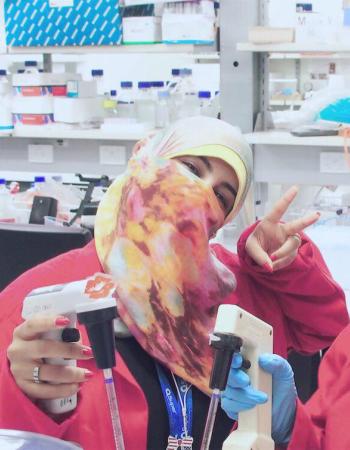Measuring the progression of upper motor neuron disease using diffusion MRI and its correlation with Clinical phenotype
, Ashwag R. Alruwaili . 2017
Background: Amyotrophic lateral sclerosis (ALS) is a progressive neurodegenerative
disease that affects motor and extra-motor systems. Diffusion tensor imaging (DTI) can
be used to assess white matter (WM) tracts and has potential to be a marker of disease
progression.
Aims: This study aims to assess the abnormalities in brain white and gray matter in
patients with amyotrophic lateral sclerosis (ALS) using MRI. It focuses on the white
matter changes associated with cognitive change and serial studies in patients with
ALS.
Methods: MRI data were acquired in a total of 30 patients and 19 healthy controls.
Patients were scanned up to three times with 6–month intervals on a 3T MRI. ALSFRSR
and cognitive testing were administered at each clinical visit. The MRI included a
T1-weighted image and diffusion weighted MRI along 64 directions. MRI data were
analyzed using voxel-based morphometry (VBM), and tract-based spatial statistics
(TBSS) for all DTI metrics, sub-grouping ALS patients based on their cognitive
performance. For the serial studies, TBSS and region-of-interest (ROI) methods were
applied to the longitudinal datasets. In the 6–month follow-up study, total number of
ALS subjects was 23, FA and MD were measured for the motor and extra-motor
pathways and correlated with the revised ALS functional rating scale (ALSFRS–R) and
disease duration. TBSS and ROI methods, both manual and atlas-based approaches,
were used for the 12–month follow-up study which included only 15 subjects. Results
for both ROI approaches were compared.
Results: There was variability in clinical presentation among patients, with a mixture
of site of onset and presence/absence of cognitive changes. At the first time-point study,
all DTI measures and GM volume differed significantly between ALS subjects and
controls in motor and extra-motor regions. Comparing each ALS subgroup to controls,
greater DTI changes were present in ALS with cognitive impairment (ALScog) than
ALS subjects without cognitive impairment (ALSnon-cog) subjects. In ALS compared
to controls, there were changes on the right side and in a small region in the left middle
frontal gyrus. Comparing ALS sub-groups, GM results showed reduction in the caudate
nucleus volume in ALScog subjects. In the serial scans, when comparing all ALS timepoints,
the TBSS showed no significant changes between the first two scans or at three
time-points. Using ROI method for 6-month follow-up, the average changes in FA and
MD in the selected ROIs were small and not significant after correcting for multiple
com parisons. The FA correlated with ALSFRS-R in the genu of corpus callosum (gCC)
and bilaterally in the forceps minor and inferior longitudinal fasciculus (ILF) at first
scan but not at the second scan. The MD in the hippocampus WM tracts (Hpc), the
association fibers and anterior limb of internal capsule (ALIC), gCC and corona radiata
(CR) correlated with disease duration and ALSFRS-R. Over 12-month follow-up, when
TBSS group comparison were performed for each time-point compared to controls, the
changes in serial three time-points were mainly along the cortico-spinal tract (CST) and
the whole corpus callosum (CC). ROI methods showed no significant differences in the
average FA in the posterior limb of internal capsule (PLIC) or CST at the pons between
time-point. There was a significant correlation of the values for the rate of loss in the
left PLIC with survival and the correlation approached significance for the right PLIC.
Linear regression analysis showed a significant relationship between the manual and
atlas based methods for the PLIC but not the pons. However, this study found that
manual ROI (mROI) is correlated with the atlas-based ROI (aROI).
Conclusion: The combined DTI and VBM study at the first time point showed changes
in motor and extra-motor regions in patients with ALS compared to controls. The DTI
changes were more extensive in ALS with cognitive impairment than pure ALS
subjects. It is likely that the inclusion of ALS subjects with cognitive impairment in
previous studies resulted in extra-motor WM abnormalities being reported in ALS
subjects. Our study finds that there was little change in the DTI over time in patients
with ALS. However, there was variability in clinical features among patients. For
individuals there is some correlation with disease progression, measured by ALSFRSR
and survival. Our results would suggest that better results are obtained from the PLIC
than the CST in the pons.

Increasing numbers of patients who recover from COVID-19 report lasting symptoms, such as fatigue, muscle weakness, dementia, and insomnia, known collectively as post-acute COVID syndrome or long…

Abstract
Background

Background: Amyotrophic lateral sclerosis (ALS) is a progressive neurodegenerative
disease that affects motor and extra-motor systems. Diffusion tensor imaging (DTI) can…

